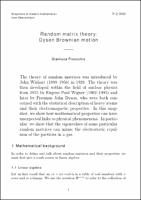| dc.contributor.author | Finocchio, Gianluca | |
| dc.contributor.editor | Munday, Sara | |
| dc.contributor.editor | Kohlrus, Jan | |
| dc.contributor.editor | Jahns, Sophia | |
| dc.date.accessioned | 2020-04-15T11:09:56Z | |
| dc.date.available | 2020-04-15T11:09:56Z | |
| dc.date.issued | 2020-04-15 | |
| dc.identifier.uri | http://publications.mfo.de/handle/mfo/3736 | |
| dc.description.abstract | The theory of random matrices was introduced by
John Wishart (1898–1956) in 1928. The theory was
then developed within the field of nuclear physics
from 1955 by Eugene Paul Wigner (1902–1995) and
later by Freeman John Dyson, who were both concerned
with the statistical description of heavy atoms
and their electromagnetic properties. In this snapshot,
we show how mathematical properties can have
unexpected links to physical phenomenena. In particular,
we show that the eigenvalues of some particular
random matrices can mimic the electrostatic repulsion
of the particles in a gas. | en_US |
| dc.language.iso | en | en_US |
| dc.publisher | Mathematisches Forschungsinstitut Oberwolfach | en_US |
| dc.relation.ispartofseries | Snapshots of modern mathematics from Oberwolfach;2020,02 | |
| dc.rights | Attribution-ShareAlike 4.0 International | * |
| dc.rights.uri | http://creativecommons.org/licenses/by-sa/4.0/ | * |
| dc.title | Random matrix theory: Dyson Brownian motion | en_US |
| dc.type | Article | en_US |
| dc.identifier.doi | 10.14760/SNAP-2020-002-EN | |
| local.series.id | SNAP-2020-002-EN | en_US |
| local.subject.snapshot | Algebra and Number Theory | en_US |
| local.subject.snapshot | Probability Theory and Statistics | en_US |
| dc.identifier.urn | urn:nbn:de:101:1-2020042112491393102326 | |
| dc.identifier.ppn | 1695803531 | |


